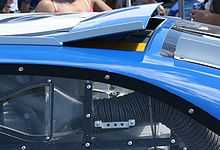Roof flap

A roof flap is an aerodynamic feature on race cars, mainly stock cars, which functions as an emergency spoiler to prevent the vehicle from lifting off the ground. The flaps are stowed during normal vehicle operation; however, in certain situations, e.g., if the vehicle goes into a spin, particularly if it is facing backwards, the flaps deploy to disrupt the air flow over the roof and reduce the lift force on the vehicle.
NASCAR mandates that cars in the Sprint Cup and Nationwide series have two roof flaps positioned near the rear of the vehicle, with the left flap oriented perpendicular to the length of the car and the right flap angled 45° counter-clockwise (when looking downward) from the left flap.[1] Trucks in the Camping World Truck Series only have the angled flap, due to the smaller roof area of the pickup truck type greenhouse and lower overall lift potential of the body shape.
Originally, the flaps each measured 12 inches (30 cm) wide by 8 inches (20 cm) tall.[1] Following several incidents where cars became airborne in Sprint Cup races in preceding years, NASCAR mandated new, larger flaps to increase their effectiveness, introduced with the "Generation Six" body style in 2013. The new flaps are designed to deploy more quickly than the previous design, and include canvas "parachutes" on their underside to further disrupt airflow when deployed.[2]
A race car's body is designed to optimize downforce, but if that body is spun so air is flowing in reverse, lift is generated instead of countered.[1] The roof flaps' job is to disrupt that airflow and prevent lift.[3]
The decision to implement a safety device to keep cars on the ground came after two crashes in 1993. In the first, Rusty Wallace barrel-rolled through the infield Talladega in 1993 after being tagged by Dale Earnhardt exiting the tri-oval. Wallace's car spun backwards, and lifted off the ground. The car landed in a grassy area of the track and his car tumbled violently down the frontstretch. In August Johnny Benson spun off turn two at Michigan and flipped down the backstretch.
NASCAR tested a restrictor plate at Charlotte that September but driver lobbying led to development of the roof flaps. "We developed them so NASCAR would not slow the cars down more," said the devices' primary engineer, Jack Roush.
References
- ↑ 1.0 1.1 1.2 Leslie-Pelecky, Diandra L. (2008). The physics of NASCAR: how to make steel + gas + rubber. Dutton. pp. 103–104. ISBN 0-525-95053-2.
- ↑ Caraviello, David (January 18, 2013). "New roof flaps help keep NASCAR cars grounded". NASCAR.com. Retrieved January 18, 2013.
- ↑ Ryan, Nate (April 28, 2009). "NASCAR: Edwards' roof flaps worked properly at Talladega". USA Today. Retrieved May 28, 2010.